 |
|||||||||||||||||||||||||||||||||||||||||||
 |
 |
||||||||||||||||||||||||||||||||||||||||||
| Rules of the Game | Soccer in the United State | ||||||||||||||||||||||||||||||||||||||||||
| Soccer is the World's most popular sport- weather measured by the number of participants or by the number of spectators. None one really knows when the game of soccer began. Some sort of recreation involving kicking and chasing a round object seems to have existed as long as human kind. Recorded history traces soccer's origins to ancient Greece, Rome, Egypt, and China. Somehow, the word soccer was derived from "assoc.," the shortened from of association. Soccer developed very quickly in England, and by 1888 the first professional league had been created. English travelers and settlers spread the game throughout the world. The English spread soccer worldwide, but people in different countries adopted new and different ways to play depending upon the nation or culture in which the game is played. There is the Italian style, Brazilian style, the English style, South American style, European style, And many more. There are also different names for soccer in other languages-futbol in Spanish and Portuguese, calcio in Italian, fussball in German, and so on. There are many names for soccer, but it is played with the same rules around the world, often before huge crowds. In London, 90,000 people frequently watch soccer games at Wembley Stadium. In Rio de Janeiro, Brazil, 200,000 people jam Maracana Stadium for soccer games. Soccer is both a recreational and a competitive sport. In terms of competition, soccer is played on every level-from a junior team of 6-years-olds through high school and college and up to club, professional, and national teams. | |||||||||||||||||||||||||||||||||||||||||||
| The ancient Greeks, Chinese, Egyptians and Romans all played a form of football. In the early19-th century it became an organized game in Britain, and was played in most universities and public school. Standard rules were drawn up at Cambridge university in 1848, and 1863 the Football Association was formed. The FA Cup final was played in 1872. Professionalism increased amongst northern clubs, and the game was legalized in 1885. The Football League was formed in 1888. |  |
||||||||||||||||||||||||||||||||||||||||||
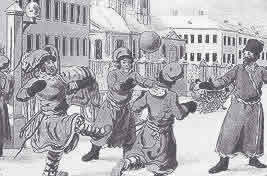 |
|||||||||||||||||||||||||||||||||||||||||||
| A Football match takes place in Russia in 1810. | |||||||||||||||||||||||||||||||||||||||||||
| The game of football began modestly enough, yet it had certain durable qualities, and it inspired a particular kind of determined devotion in its followers. The games that are now known as Rugby and Association Football began in England about halfway through the present century. There are records of earlier forms in China, at least two thousand years ago, in ancient Greece and Rome. But it was in England that football began to take the shape we now recognise, and it is here where we begin our history of soccer. | |||||||||||||||||||||||||||||||||||||||||||
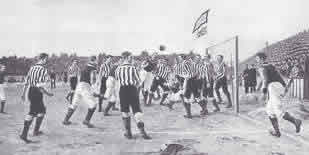 |
Soccerlike games undoubtedly predate recorded history. Historians find its ancestry in the similar but unstructured games of medieval English village life. When the London Football Association issued, its first set of rules in 1863, order was brought to the sport. All major innovations in soccer were English, such as international matches, the introduction of professionalism in 1885, and the first full-time league in 1888. Soccer | ||||||||||||||||||||||||||||||||||||||||||
| was carried to continental Europe, South America, and India by British sailors and settlers, and it gained instant appeal wherever it was played. In 1908 soccer became a medal sport in the Olympic Games. | |||||||||||||||||||||||||||||||||||||||||||
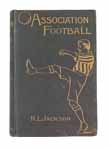 |
The Football Association Laws of 1863 regulated the game in and around London but in the provinces clubs continued to follow their local rules for some time. The most important of these regional variants was at Sheffield. It was not until 1877 that Sheffield adopted the FA Laws which, at the same time, absorbed certain clauses from the Sheffield code. There are some similarities in the formation of the Sheffield club, the oldest club in the world, and Notts County, the oldest Football League club. Both began with impromptu, informal kickabouts by a group of young men of the professional class and only after a couple of years was the club | ||||||||||||||||||||||||||||||||||||||||||
| formally founded. Sheffield was formed on October 24, 1857, after informal play since 1855, and Notts County on December 7, 1864 after informal play since 1862. The two clubs first met in the 1864-65 season, the first important match on record played by a current member of the Football League. | |||||||||||||||||||||||||||||||||||||||||||
 |
|||||||||||||||||||||||||||||||||||||||||||
 |
|||||||||||||||||||||||||||||||||||||||||||
 |
|||||||||||||||||||||||||||||||||||||||||||
| Itlay vs. England 5/16/1948 | England vs. Scotland 4/18/1953 | ||||||||||||||||||||||||||||||||||||||||||
| 1927 FA Cup Final | |||||||||||||||||||||||||||||||||||||||||||
| Soccer's international governing body, Federation Internationale de Football Associations (FIFA), was formed in 1904 with the objective of organizing championship matches between professional teams of different nations. The headquarters is in Zurich, Switzerland. Professionalism arrived in continental Europe in the 1920s and in South America less than a decade later. By 1930 the interest in soccer was high enough to ensure the success of the first World Cup, even though only 13 countries entered. Today the World Cup is soccer's most coveted prize. It is the world's most popular athletic event, possibly excepting the Summer Olympics. The 1994 World Cup finals, played in the United States, had a television audience that exceeded two billion.
No team sport approaches soccer's popularity in both Europe and South America. The professional leagues on these continents play from fall through spring in domestic competition, after which the top teams take part in international "cup," or tournament, play. The European Cup (1955) is the most prestigious on that continent; the best tournament in South America is for the Liberator's Cup (1960). Those two cup winners then meet for the annual World Club Championship.Many African nations, led by Ghana, Nigeria, and the Ivory Coast, are developing world-class soccer teams. The major international competitions in Africa are the African Cup of Nations, held biennially between national all-star teams, and the annual African Cup of Champion Clubs. Asia's best soccer, once in Iran, is now in Japan and North Korea; the People's Republic of China joined FIFA in 1980. The continuous action and fast pace of soccer have made it a major spectator sport throughout the world, and for the same reasons it has attracted millions of players. Since the late 1960s and early 1970s its growth in the United States, especially on the amateur level, has been substantial. The name of the game presents some confusion. In countries other than the United States soccer is called football. The word soccer is a shortening and altering of association football. |
|||||||||||||||||||||||||||||||||||||||||||
| Top | |||||||||||||||||||||||||||||||||||||||||||
 |
|||||||||||||||||||||||||||||||||||||||||||
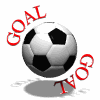 |
|||||||||||||||||||||||||||||||||||||||||||
| Rules of the Game | |||||||||||||||||||||||||||||||||||||||||||
| The rules of soccer are relatively simple, and little equipment is required. Players wear shirts, shorts, cleated shoes, and sometimes shin guards tucked inside their socks. The soccer ball, made of leather or rubber, has a circumference of 27-28 in and weighs 14-16 oz when inflated to 12-13 pi. The length of the field may be 100-130 yd, and the width, 50-100 yd; the field must always be longer than it is wide. A soccer game begins when one team kicks off, the kicking team usually retaining possession because the ball need be moved only the length of its circumference with the kickoff. Play is continuous, stopping only when a goal is scored, the ball is out of bounds, or a foul is called. Each goal scored is worth one point, and the team with the most goals at the end of play, wins. The game lasts for a specified period of time, which varies with the level and type of competition and sometimes the local rules. In most competition (including professional and U.S. intercollegiate), a soccer game is 90 minutes long, played in halves. Almost all levels of competition have provisions for some kind of overtime play to produce a winner if regulation time ends with a tie. In international play substitution is generally limited to one or two players per game; players removed from a game for any reason (injury, ejection, substitution) cannot return. In U.S. collegiate and scholastic soccer, however, any player may leave and subsequently reenter the game at any time. The game is controlled by a referee on the field who is assisted by two linesmen, one on each sideline. Intentional contact with the ball from the shoulders to the hands is forbidden, and the following constitute offenses against the opponent: intentional kicking, charging from behind or in a dangerous manner, striking, holding, pushing, tripping. For these the referee will stop play and award a direct free kick, from the point of the infraction, against the offending team. It is possible to score a goal directly with such a kick. If one of the offenses is committed by a player inside the team's own penalty area, then the other team gets a penalty kick; the ball is placed on the penalty spot, 12 yd from the goal, and only the goalkeeper may defend. Other, lesser offenses include obstruction and dangerous play, for which an indirect free kick is awarded; in this case one pass must be made before a goal can be scored. An indirect free kick is also awarded for offside violations. A player is offside if the following conditions exist: the player is in the opponent's defensive half of the field, the player's team but not that player has possession of the ball, there are less than two defenders between that player and the goal, and that player is in a position to affect the play. The linesmen have two main functions: (1) to spot offside infractions; and (2) whenever the ball goes out of play, to indicate which team has possession and where. When a ball goes beyond the sidelines, it is returned to play with an overhead, two-handed throw, with the player's feet touching the ground. When the ball goes over the goal line but not into the goal, it is either a corner kick for the attacking team (in which case the ball is kicked toward the goal) or a free kick downfield for the defending team. |
|||||||||||||||||||||||||||||||||||||||||||
| Top | |||||||||||||||||||||||||||||||||||||||||||
| Soccer in the United States | |||||||||||||||||||||||||||||||||||||||||||
| Soccer arrived in the United States during the late 19th century, but its first widespread nationwide sanction did not take place until the National Collegiate Athletic Association (NCAA) recognized (1959) it as an official collegiate sport with a national championship tournament. Soon after the formation (1967) of the North American Soccer League (NASL), now defunct, the sport became the fastest growing in the United States for young people. | |||||||||||||||||||||||||||||||||||||||||||
| The critical turning point for soccer in the United States was when Pele joined the New York Cosmos of the NASL in 1975. Perhaps history's greatest player (he led Brazil to World Cup triumphs in 1958, 1962, and 1970), he attracted fans in record numbers to NASL contests and inspired many young people to try the game. They found it easy to learn, less injurious than U.S. football, and equally enjoyable for both boys and girls. The Soccer Industry Council of America estimates that during the mid-1990s about 12 million Americans under the age of 19, 37% of them girls were playing organized soccer, ranking third among all sports, behind basketball (first) and volleyball. For the age group under 13, soccer participation ranked second after basketball. The NCAA administers more than 800 collegiate men and women's teams in all three of its divisions and organizes an annual national championship tournament in each. The smaller National Association of Intercollegiate Athletics (NAIA) also organizes an annual tournament. | |||||||||||||||||||||||||||||||||||||||||||
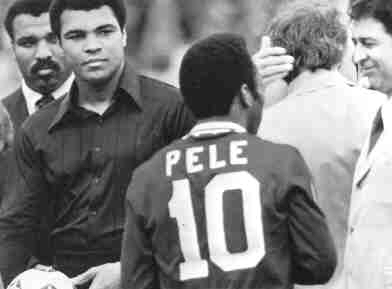 |
|||||||||||||||||||||||||||||||||||||||||||
| (on the left): Mohamad Ali with a soccer ball preapares to meet and get a autograph from Pele (on the right) | |||||||||||||||||||||||||||||||||||||||||||
| For all of soccer's continued growth and popularity at the amateur level, the U.S. professional game has lived a checkered existence. The oldest professional circuit was the American Soccer League (ASL), founded in 1921. After surviving for 50 years, several of its 7 teams withdrew in 1983 to form another organization, the United Soccer League (USL). This caused the ASL's demise, and the USL folded in mid-1985. The most visible U.S. professional soccer organization was the NASL, founded in 1966. It expanded to 21 teams by 1981. The dominant team was the Cosmos, who won the league championship three times from 1977 to 1980, primarily because they imported such stars as Franz Beckenbauer, Giorgio Chinaglia, Pele, and Carlos Alberto. Other foreign greats who played on NASL teams included George Best, Johan Cruyff, Teofilo Cubillas, and Gerd Mueller. By 1984 the NASL had only 9 teams, and the combination of decreasing spectator interest and near absence of television revenue caused the league to shut down after the 1984 season. Indoor soccer, begun in 1939, is played during the winter months. Indoor soccer is played with a regulation ball by five players and a goalkeeper on a hockey-Rink like Astro Turf field surrounded with Plexiglas. The goals are also smaller than those in outdoor soccer, and substitutions are unlimited. The Major Indoor Soccer League operated from 1978 to 1992; the NASL had its own indoor league from 1979 to 1984. |
|||||||||||||||||||||||||||||||||||||||||||
 |
A national team, including a number of international-caliber players, played in the 1994 World Cup, with better than expected success. There are four soccer leagues presently active in the United States: the seven-team American Professional Soccer League, playing in the United States and Canada; the 13-team National Professional Soccer League; the 15-team Continental Indoor Soccer League, based | ||||||||||||||||||||||||||||||||||||||||||
| primarily in the western states; and Major League Soccer (MLS). MLS, organized as part of the 1994 World Cup effort, began play in 1996. Its ten teams include leading members of the 1994 national team, as well as some international stars. | |||||||||||||||||||||||||||||||||||||||||||
| Top | |||||||||||||||||||||||||||||||||||||||||||
 |
|||||||||||||||||||||||||||||||||||||||||||